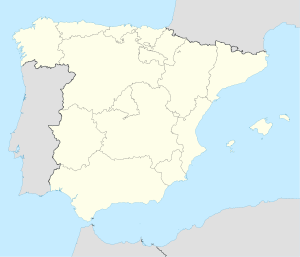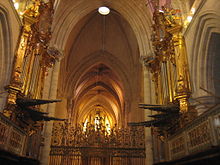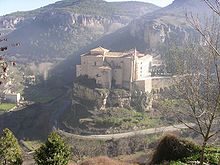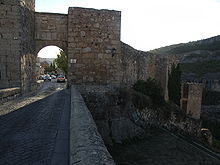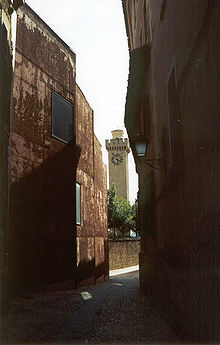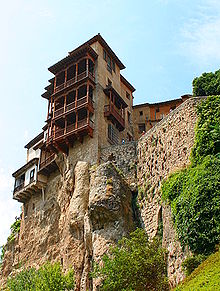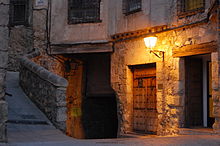- Cuenca, Spain
-
Cuenca 
Flag
Coat of armsCoordinates: 40°4′N 2°9′W / 40.067°N 2.15°W Country  Spain
SpainAutonomous community Castile-La Mancha Province Cuenca Comarca Serranía Media Government – Mayor Juan Ávila Area – Total 911.06 km2 (351.8 sq mi) Elevation 946 m (3,104 ft) Population (2010) – Total 56,189 – Density 61.7/km2 (159.7/sq mi) Demonym Conquenses Time zone CET (UTC+1) – Summer (DST) CEST (UTC+2) Postal code 16000 Website Official website Cuenca (Spanish pronunciation: [ˈkweŋka]) is a city in the autonomous community of Castile-La Mancha in central Spain. It is the capital of the province of Cuenca.
Geography and climate
Cuenca is located across a steep spur, whose slopes descend into deep gorges of the Júcar and Huécar rivers. It is divided into two separate settlements: the "new" city is situated south-west to the old one, which is divided by the Huécar course.
The climate of Cuenca is the typical continental Mediterranean of Spain's "Meseta" (inner plateau). Winters are relatively cold, but summers are quite hot. Spring and autumn seasons are short, with pleasant temperatures during the day but with rather cold nights due to its altitude from 956 m above sea level up to 1000 m in the old town.
Average / Month Average Jan Feb Mar Apr May Jun Jul Aug Sep Oct Nov Dec High temperature Celsius 18.8 9.4 11.1 14.2 15.7 20.1 25.9 30.7 30.3 25.5 16.6 13.1 10 Low temperature Celsius 6.3 -0.7 0.3 1.7 4.9 7.6 11.7 14.7 14.8 11.3 6.8 2.7 0.7 Precipitation millimetres year: 507 45 41 32 56 60 44 15 17 47 53 49 58 Source: AEMET Historic Walled Town of Cuenca * UNESCO World Heritage SiteCountry Spain Type Cultural Criteria ii, v Reference 781 Region ** Europe and North America Inscription history Inscription 1996 (20th Session) * Name as inscribed on World Heritage List
** Region as classified by UNESCOHistory
When the Iberian peninsula was part of the Roman Empire there were several important settlements in the province, such as Segóbriga, Ercávica and Gran Valeria. However, the place where Cuenca is located today was uninhabited at that time.
When the Muslim Arabs captured the area in 714, they soon realized the value of this strategic location and they built a fortress (called Kunka) between two gorges dug between the Júcar and Huécar rivers, surrounded by a 1 km-long wall. Cuenca soon became an agricultural and textile manufacturing city, enjoying growing prosperity.
Around the 12th century the Christians, living in northern Spain during the Muslim presence, started to slowly recover the Iberian peninsula. Castile took over western and central areas of Spain, while Aragon enlarged along the Mediterranean area. The Muslim Kingdom, Al-Andalus, started to break into small provinces (Reinos de taifas) under Christian pressure, Cuenca being part of the taifa of Toledo. In 1076 it was besieged by Sancho Ramírez of Aragon, but not conquered. In 1080 King Yahya al-Qadir of Toledo lost his taifa, and his vizier signed in Cuenca a treaty with Alfonso VI of León and Castile by which he ceded him some fortresses in exchange of military help.
After Alfonso's defeat in the battle of Sagrajas (1086), Cuenca was captured by the King of Seville, Al-Mu'tamid ibn Abbad. However, when his lands were attacked by the Almoravids, he sent his daughter-in-law Zaida to Alfonso, offering him Cuenca in exchange of military support. The first Christian troops entered the city in 1093. However, the Almoravids captured it in 1108. Their governor in the city declared himself independent in 1144, followed by the whole Murcia the following year. In 1147 Muhammad ibn Mardanis was elected King of Cuenca, Murcia and Valencia. He had to defend his lands from the Almohad invasion until his death 1172, after which his son had to sign a pact of tributes with the newcomers. A 17 year old Alfonso VIII of Castile tried to conquer the city, but after five months of siege, he had to retreat after the arrival of troops sent by the Almohad caliph Abu Yaqub Yusuf. Alfonso signed a 7-years truce but when, in 1176 the Cuencans occupied some Christian lands in Huete and Uclés, Alfonso intervened at the head of a coalition including also Ferdinand II of León, Alfonso II of Aragon and the Military Orders of Calatrava, Santiago and Montegaudio, besieging Cuenca for months startign from 1177's Epiphany. The city's commander, Abu Bakr, sued again the support of Yaqub Yusuf, but the latter was in Africa and did not send any help. After an unsuccessful Cuenca sortie against he Christian camp on 27 July, the besieged city was conquered by Alfonso's troops on September 21, 1177, while the Muslim garrison took refuge in the citadel.
The latter fell in October, putting an end to the Arab domination in Cuenca. Alfonso VIII granted the city a title, and it was considered to be "Muy noble y muy leal" (Very noble and very loyal). It was given a set of laws, the Fuero, written in Latin, that ruled Cuenca's citizens, and it was considered one of the most perfectly written at that period of time. The diocese of Cuenca was established in 1183; its second bishop was St. Julian of Cuenca, who became patron saint of the city.
During the next few centuries Cuenca enjoyed prosperity, thanks to textile manufacturing and livestock exploitation.The cathedral started to be built at that time, in an Anglo-Norman style, with many French workers, since Alfonso VIII's wife, Leonor de Plantagenet, was French.
During the 18th century the textile industry declined, especially when Carlos IV forbade this activity in Cuenca in order to prevent competition with the Real Fábrica de Tapices (Royal Tapestry Factory), and Cuenca's economy declined, thus losing population dramatically (5,000 inhabitants). During the independence war against Napoleon's troops the city suffered great destruction, and it made the crisis worse. The city lost population, with only around 6,000 inhabitants, and only the arrival of railroads in the 19th century, together with the timber industry, were able to boost Cuenca moderately, and population increased as a result to reach 10,000 inhabitants. In 1874, during the Third Carlist War, Cuenca was taken over by Carlist troops, supporters of Carlos María Isidro as king instead of the ruling Isabel II, and the city suffered great damage once more.
The 20th century began with the collapse of the Giraldo cathedral's tower in 1902, which affected also the façade. It had to be rebuilt by Vicente Lámperez, with two new twin towers at both ends of the façade which have remained unfinished without the upper part of them.
The first decades of the 20th century were as turbulent as in other regions of Spain. There was poverty in rural areas, and the Catholic Church was attacked, with monks, nuns, priests and a bishop of Cuenca, Cruz Laplana y Laguna, being murdered. During the Spanish Civil War Cuenca was part of the republican zone (Zona roja or: "the red zone"). It was taken in 1938 by General Franco's troops. During the post-war period the area suffered a major economic decline, causing many people to migrate to more prosperous regions, mainly the Basque Country and Catalonia, but also to other countries such as Germany. The city started to recover slowly from 1960 to 1970, and the town limits went far beyond the gorge to the flat surroundings.
Within recent decades the city has experienced a moderate growth in population and economy, the second one especially due to the growing tourism sector, and both of them fuelled by improvements in road and train communications. Cuenca has strongly bet on culture and as a result of this it was declared a World Heritage site in 1996. In the recent years, new cultural infraestructures such as the municipal Concert Hall or the Science Museum place Cuenca in a good position to apply for the title of European Capital of Culture in 2016.
Main sights
Our Lady of Grace cathedral
Main article: Cuenca CathedralCuenca Cathedral was built from 1182 to 1270. The façade was rebuilt after it crumbled down in 1902. It is the first gothic style Cathedral in Spain (together with Avila's one), because of the influence of Alfonso VIII's wife, Eleanor, daughter of the King of England and his wife, Eleanor of Aquitaine, who introduced the Anglo-Norman style.
From that date the cathedral has undergone some changes. An apse-aisle (doble girola) was added in the 15th century, while the Renaissance Esteban Jamete's Arch was erected in the 16th century. The main altar was redesigned during the 18th century by famous architect Ventura Rodríguez: it features a precious iron-work gate. The façade was rebuilt in 1902 from ruins due to the collapse of the former bell tower, the Giraldo. In the early 1990s modern coloured windows were installed, and in 2006 one of the two old baroque organs from Julián de la Orden was recovered. The other organ has also been restored, and on 4 April 2009 an inauguration ceremony was held.
The naves do not follow exactly a straight line. The San Julián altar, dedicated to Saint Julian of Cuenca, at the apse-aisle, consists of columns made of green marble.
Another curiosity are the "Unum ex septem" signs at some chapels. It is said that if one prays looking at these signs one would obtain a five-year forgiveness for one's sins, and seven years if one prays during the patron saint's day.
Saint Peter church
With Romanesque origins, the church of St. Peter (San Pedro) was rebuilt by Jose Martin de la Aldehuela during the 18th century and displays since that time a Baroque façade. It shows an octagonal shape outdoors but it is circular inside, and it is located at Plaza del Trabuco.
This church can be reached by going up along San Pedro Street from Plaza Mayor.
Saint Michael church
The Iglesia de San Miguel was erected during the 13th century, with only one nave and an apse. In the 15th century a second nave at the north side was added. The dome was built by Esteban Jamete in the 16th century and finally the wooded ceiling of the two naves was changed by stone-made vaults during the 18th century.
Saint Michael was restored in the 20th century, and its management was transferred to Cuenca's municipality from Cuenca's Diocese, so that this church could be used to hold classical music concerts. In fact, Saint Michael is home of the Religious Music Week (Semana de Musica Religiosa) together with other places within the city and its province.
It is located at San Miguel street, next to Plaza Mayor. Saint Michael is accessed through a descending narrow passage which starts at Plaza Mayor left lateral (looking from the Town Hall).
The Savior church (Iglesia del Salvador)
Built in neogothic style during the 18th century, with only one nave and a high tower. It shows a modest baroque façade and some remarkable baroque altars indoors. The door is however quiet modern, added in the late 1990s.
The famous religious procession "Las Turbas", held on Good Friday morning, starts at this location, since the image of "Jesús el Nazareno", which is at the forefront of the procession, is kept within "El Salvador".
Saint Paul bridge
The St. Paul bridge (Puente de San Pablo) was built from 1533 to 1589, a construction driven by the canon Juan del Pozo, over the river Huecar's Gorge, aiming at connecting the old town with St Paul convent.
The original bridge collapsed, and the current one was built in 1902, made of wood and iron according to the style dominating at the beginning of the 20th century. It is up to 40 metres high, and supported upon the remains of the old bridge.
Seminary
The Seminary (Seminario), a rectangular building stretching from Plaza de la Merced to Mangana Square, was established under the ruling of the bishop José Flores Osorio and built by Vicente Sevilla, around 1745. The magnificent baroque façade at Plaza de la Merced was however set up in 1748.
It holds a library with numerous ancient books, some of them “incunables” (previous to 1501). There is also a Rococo meeting room inside and a Gothic altarpiece at the chapel, but visits are not allowed.
In 2004 some books from this library were stolen, but the suspect of the robbery was caught and the books recovered before entering on an auction process.
Now an average of 10-15 future priests are trained there, according to Spanish Episcopal Conference link statistics.
The old Saint Paul convent
St Paul convent was built in the 16th century by command of the canon priest Juan del Pozo, a monk belonging to the Dominican Order. Brothers Juan and Pedro de Alviz were in charge of the building project; Pedro worked on the convent and the cloister and Juan on the church.
The church was finished in the 18th century, in rococo style.
The convent was ruled by Dominican monks, but during the 19th century was handed over to the Pauline Fathers, who were based here until 1975, when they left due to the possible collapse of the building. In the 1990s the convent was restored to house the Parador Nacional de Turismo de Cuenca, a hotel.
The cloister has an ornamental source of water, and the cafeteria is the old chapel. From the convent the old town can be reached easily by crossing St Paul bridge.
Bishop's Palace
The bishop's palace features, on three of its museums, the Diocese's Museum, which has a remarkable collection of religious art. It can be easily accessed from the Cathedral.
The rooms where the collection is shown were remodeled by architect Fernando Barja Noguerol, and Gustavo Torner selected the art pieces from an inventory made by some priests of the Diocese in 1977. Some of the diocese's artistic patrimony was lost during the Peninsular War, the confiscation of ecclesiastical property by Juan Álvarez Mendizábal, and the Spanish Civil War.
Masterpieces like The Byzantine Diptych (book-like silver work whose origin is dated around 1370, containing saints' relics), paintings by El Greco, and handcrafted carpets from Cuenca's school, can be seen at the museum.
El Castillo (The Castle)
El Castillo is the name for the remains of an ancient Arab fortress, representing the older structures of Cuenca. Only a tower, two stone blocks, the arch which allows to enter/leave the old town from the Barrio del Castillo and a fragment of the walls have been left. The arch (arco de Bezudo) is named after Gutierre Rodriguez Bezudo, from Segovia, who fought the Arabs with King Alfonso VIII to conquer Cuenca.
The castle was home of the Holy Inquisition after 1583, and it was finally destroyed during the 19th century by French soldiers during the Spanish War of Independence.
Nearby are the small chapel and cemetery of San Isidro.
Mangana Tower
Origins of the Mangana Tower remain unclear. In 1565 it was painted by Antoon van den Wijngaerde, which indicates that at that time Mangana had already been built up, and after the attacks by French soldiers during the Spanish War of Independence war - at the beginning of the 19th century - and having been hit previously by a thunderbolt in the 18th century, it became badly destroyed. Mangana Tower was rebuilt by Fernando Alcántara in Neomudejar style - inspired on Arab decorative motifs - in 1926. Finally Victor Caballero gave Mangana its current look in a fortress-like style in 1968.
It has a clock on one of its walls and a recording of bell chimes can be heard in the old town at certain times (every quarter of an hour).
There are views from the near viewpoints over the river Jucar's gorge and the modern neighborhoods. Mangana can be reached on foot from Plaza Mayor.
Town Hall
The Town Hall (Ayuntamiento) is a building in baroque style built up during the ruling period of king Charles III and supported over three roman arches. It was finished in 1762, as it can be read on the façade.
The central arch is the only one giving access to vehicles to Plaza Mayor.
Hanging Houses
Built over a rock above the Huecar River Gorge in the 15th century, Las Casas Colgadas are the only remaining samples of this type of building which was common in this city a long time ago.
Las Casas Colgadas can be considered the most famous civil buildings in Cuenca. They house a restaurant and the Museum of Abstract Arts and they serve as the background of millions of photos made from the bridge of San Pablo.
Monument devoted to the Holy Heart of Jesus
On top of the Cerro del Socorro you can find the monument devoted to the Holy Heart of Jesus, whose materials were transported on donkeys in the mid-20th century. This place is a magnificent viewpoint over the city. It can be accessed by taking the road to Palomera / Buenache de la Sierra (Huecar river's Gorge) and turn right after 5 km, approx.
Cuenca Province council
The provincial council's seat (Diputación provincial de Cuenca) is a building with 2 floors built at the beginning of the 20th century according to a project conceived by provincial architect Rafael Alfaro. The Cuenca shield at the façade is made of Carrara marble.
Others
Other notable buildings in Cuenca include the San Felipe Neri church, the Our Lady of Light church (Iglesia de Nuestra Señora de La Luz) and the Las Petras convent.
Museums
- Archeological Museum
- Diocese's Museum
- Museum of Abstract Art
- Museum of Science of Castile-La Mancha
Parks
- El Escardillo, with a few trees and a fountain over a small patch of ground. It is one of the few green areas in the old town.
- Los Moralejos: located near the entry point from Madrid, Los Moralejos, also known as "Carrero" (its old name was Carrero Blanco, the VP of General Franco), is a park which was enlarged in the early nighties, when San Julian's fair was moved to its current location, thus releasing some amount of land. A bicycle lane has been built recently, as well as a new connection with the "el Sargal" sport centre.
- Santa Ana, "El Vivero", near to the Cuenca's bullring, large trees give shadow to most of the park.
- San Fernando: located in the expansion area of Cuenca, it is settled on a slope and features, among other attractions, three small lakes.
- San Julián, the oldest one in Cuenca, created at the beginning of the 20th century, from land donated by Gregoria Fernández de la Cuba, whose sculpture can be found here. San Julián's park is an example of sustainable design: there is no grass, instead the rectangles of terrain along the perimeter contain large trees, and are separated by bush rows and sand paths. In the centre, an open space houses a bandstand. An sculpture of Lucas Aguirre y Juárez, which devoted its filantropic efforts to education of poor children, is also here. A fully functional "Manneken pis" relieves thirsty passers-by during the summer days.
Festivities
- Jueves Lardero
- St. Julian's Day (Julian of Cuenca) - January 28
- Saint Matthew's Day - September 21: a young bull (la vaquilla) is released on the streets being led by people with ropes, while people from Cuenca, grouped in "peñas", eat and drink on the streets during four days. The first day peñas get to Plaza Mayor on foot while being watered by the old town inhabitants from their balconies. Really amusing.
Name origin
Its name may derive from the Latin conca meaning "river basin", referring to the gorge of the rivers Júcar and Huécar. It may also be derived from the now-ruined Arab castle, Kunka. Other alternative original names have been suggested, including "Anitorgis", "Sucro" or "Concava". The city of Cuenca is also known as the "Eagle's Nest" because of its precarious position on the edge of a gorge.
Transportation
The city is a popular day or weekend trip from Madrid, to which it is very well connected. On 2010 December 19 a new AVE high-speed rail link was established between Madrid - Atocha station and Cuenca - Fernando Zobel station, providing travellers with frequent connections everyday, and reducing the journey time to only 50 minutes. RENFE also operates a non high-speed service taking 3 hours going from Madrid. Auto Res, a bus operator, links Madrid to Cuenca with a 2 hour or 2:30 hour trip duration. The A-40 motorway, recently completed, connects the city with the A-3 at Tarancon, 82 km away from Madrid, thus totalling 166 km to Spain's capital. Cuenca is 200 km far from Valencia, via the A-3 in the opposite sense.
Twin towns - sister cities
Cuenca is twinned with:
Gastronomy
The following are typical dishes from the Cuenca area, being basically the result of combining those of Serranía and Mancha areas:
- Ajo arriero, made of cod, potato and garlic, can be spread on bread
- Cordero, some pieces of lamb simply roasted or in caldereta
- Morteruelo, a kind of pâté made of different kinds of meat, mainly hare, partridge, hen and pork.
- Pisto manchego, a mixture of vegetables (tomato, pepper, courgette/zuchinni) cut up and fried together, similar to the "ratatouille" from France.
- Queso manchego, coming from Villarejo de Fuentes, Santa María del Campo Rus or Villamayor de Santiago, made only from sheep's milk
- Setas, during the autumn a great variety of mushrooms can be collected in the forests near Cuenca. The most frequent is the so called Níscalo, but other species, such as boletus, can also be found.
- Trucha, trouts from the mountain rivers just grilled
- Oreja, Forro, Panceta: different cuts of pork usually grilled
For dessert, the Alajú is an Arab cake made of honey, almonds, nuts and grated orange rind. Resoli is a typical drink, served in a glass with ices or directly drunk from a "porrón" after a meal.
Gallery
See also
- Ciudad Encantada in Cuenca.
External links
- Official website
- Webcam in a side street
- Photos Monastery San Pablo at Pasaporteblog.com
- A Stroll Through La Mancha by The Guardian
World Heritage Sites in Spain For official site names, see each article or the List of World Heritage Sites in Spain.North West Caves of Altamira and Paleolithic Cave Art of Northern Spain1 · Monuments of Oviedo and the Kingdom of the Asturias · Roman Walls of Lugo · Route of Santiago de Compostela1 · Santiago de Compostela · Tower of Hercules
North East Caves of Altamira and Paleolithic Cave Art of Northern Spain1 · Mudéjar Architecture of Aragon · Pyrénées - Mont Perdu2 · Rock-Art of the Mediterranean Basin on the Iberian Peninsula1 · Route of Santiago de Compostela1 · San Millán Yuso and Suso Monasteries · Vizcaya Bridge
Community of Madrid Aranjuez Cultural Landscape · El Escorial · University and Historic Precinct of Alcalá de Henares
Centre Archaeological Ensemble of Mérida · Archaeological Site of Atapuerca · Ávila with its Extra-mural Churches · Burgos Cathedral · Cáceres · Cuenca · Las Médulas · Rock-Art of the Mediterranean Basin on the Iberian Peninsula1 · Route of Santiago de Compostela1 · Salamanca · Santa María de Guadalupe · Segovia and its Aqueduct · Toledo · Prehistoric Rock-Art Sites in the Côa Valley and Siega Verde
East Archaeological Ensemble of Tarraco, Tarragona · Catalan Romanesque Churches of the Vall de Boí · Ibiza (Biodiversity and Culture) · Palau de la Música Catalana and Hospital de Sant Pau, Barcelona · Palmeral of Elche · Poblet Monastery · Rock-Art of the Mediterranean Basin on the Iberian Peninsula1 · Silk Exchange in Valencia · Works of Antoni Gaudí
South Alhambra, Generalife and Albayzín, Granada · Cathedral, Alcázar and Archivo de Indias, Seville · Córdoba · Doñana · Renaissance Monuments of Úbeda and Baeza · Rock-Art of the Mediterranean Basin on the Iberian Peninsula1
Canary Islands 1 Shared with other region/s · 2 Shared with FranceCapitals of provinces of Spain - A Coruña
- Albacete
- Alicante
- Almería
- Ávila
- Badajoz
- Barcelona
- Bilbao
- Burgos
- Cáceres
- Cádiz
- Castellón de la Plana
- Ciudad Real
- Córdoba
- Cuenca
- Donostia-San Sebastián
- Girona
- Granada
- Guadalajara
- Huelva
- Huesca
- Jaén
- Logroño
- Las Palmas de Gran Canaria
- León
- Lleida
- Lugo
- Madrid
- Málaga
- Murcia
- Ourense
- Oviedo
- Palencia
- Palma
- Pamplona
- Pontevedra
- Salamanca
- Santander
- Santa Cruz
- Segovia
- Seville
- Soria
- Tarragona
- Teruel
- Toledo
- Valencia
- Valladolid
- Vitoria-Gasteiz
- Zamora
- Zaragoza
 Categories:
Categories:- Cuenca Province (Spain)
- World Heritage Sites in Spain
- Municipalities in Cuenca
- Populated places in Cuenca
Wikimedia Foundation. 2010.

